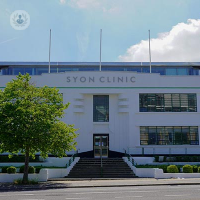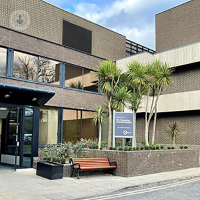What are leg ulcers?
A leg ulcer is a chronic, unhealed sore which generally develops on the inside of the leg. Leg ulcers form when there is a break in the skin of the leg, and bacteria and air get into the tissue underneath.

Prognosis
With the right treatment, most leg ulcers are able to heal within 3 to 4 months. However, if you have had one ulcer, it is possible that another could develop in the years following. If your doctor believes you may be at risk of developing further ulcers, they may suggest you wear compression stockings, which squeeze the legs and improve circulation. Ulcers are more likely to come back if the cause of the ulcer is not identified and treated properly.
Symptoms of leg ulcers
Symptoms can include:
- Itchy skin on the legs
- Scaly or hardened skin around the ulcer
- Red or flaky skin
- Unpleasant-smelling discharge coming from the ulcer
- Discolouration of the skin
- Swollen ankles
- Swollen legs
- Swollen veins on the legs
Medical tests to diagnose leg ulcers
An ulcer can be diagnosed by assessing the symptoms and looking at the leg which is affected, but in order to properly treat the leg ulcer, the cause must be determined. In order to find the cause of the leg ulcer, your doctor will ask you about any underlying conditions or injuries to the leg you might have had (e.g a deep vein thrombosis, previous ulcers). Your doctor will examine your legs in both a standing and lying position, as varicose veins are more visible when standing.
Certain tests may be performed to determine the cause of the leg ulcer, and investigate for problems with the veins or arteries in the legs, such as ultrasounds, CT scans, or MRIs.
What are the causes of leg ulcers?
As skin cells break down, air and bacteria can get in to the tissue below. Generally, the underlying cause of leg ulcers is disease in the veins of the leg, and problems with the blood supply to the skin. There are different types of leg ulcer with different causes:
- Venous ulcer, accounting for about 80% of all leg ulcers. This occurs when the veins in the leg do not function as they should.
- Arterial ulcer, accounting for 15% of leg ulcers, and occurring due to problems with the arteries.
- Leg ulcers caused by other conditions, such as diabetes and rheumatoid arthritis, accounting for the remaining 5% of ulcers.
Can leg ulcers be prevented?
If you are at risk from leg ulcers, it can help to wear compression stockings. Leg ulcers may also be prevented and risk may be reduced by exercising regularly, and losing weight if you are overweight.
Treatments for leg ulcers
First, the wound will be cleaned to remove any dead tissue from the area. Then, a dressing will be applied which allows the ulcer to heal. This dressing will need changing, but your doctor or healthcare provider will explain to you how you should clean and dress the ulcer again. This, however, is a temporary treatment for leg ulcers, and does not address the underlying cause. Depending on the cause of the ulcers, they may be treated with endovenous surgery, a minimally-invasive procedure which treats the veins themselves.
Which type of specialist treats leg ulcers?
Doctors specialising in conditions affecting the veins and venous system are able to diagnose and treat leg ulcers. Vascular surgeons and general surgeons are able to treat leg ulcers, the former being a specialist in conditions affecting the venous system.
05-24-2017 05-16-2023Leg ulcers
Mr Benjamin Lindsey - Surgery
Created on: 05-24-2017
Updated on: 05-16-2023
Edited by: Conor Dunworth
What are leg ulcers?
A leg ulcer is a chronic, unhealed sore which generally develops on the inside of the leg. Leg ulcers form when there is a break in the skin of the leg, and bacteria and air get into the tissue underneath.

Prognosis
With the right treatment, most leg ulcers are able to heal within 3 to 4 months. However, if you have had one ulcer, it is possible that another could develop in the years following. If your doctor believes you may be at risk of developing further ulcers, they may suggest you wear compression stockings, which squeeze the legs and improve circulation. Ulcers are more likely to come back if the cause of the ulcer is not identified and treated properly.
Symptoms of leg ulcers
Symptoms can include:
- Itchy skin on the legs
- Scaly or hardened skin around the ulcer
- Red or flaky skin
- Unpleasant-smelling discharge coming from the ulcer
- Discolouration of the skin
- Swollen ankles
- Swollen legs
- Swollen veins on the legs
Medical tests to diagnose leg ulcers
An ulcer can be diagnosed by assessing the symptoms and looking at the leg which is affected, but in order to properly treat the leg ulcer, the cause must be determined. In order to find the cause of the leg ulcer, your doctor will ask you about any underlying conditions or injuries to the leg you might have had (e.g a deep vein thrombosis, previous ulcers). Your doctor will examine your legs in both a standing and lying position, as varicose veins are more visible when standing.
Certain tests may be performed to determine the cause of the leg ulcer, and investigate for problems with the veins or arteries in the legs, such as ultrasounds, CT scans, or MRIs.
What are the causes of leg ulcers?
As skin cells break down, air and bacteria can get in to the tissue below. Generally, the underlying cause of leg ulcers is disease in the veins of the leg, and problems with the blood supply to the skin. There are different types of leg ulcer with different causes:
- Venous ulcer, accounting for about 80% of all leg ulcers. This occurs when the veins in the leg do not function as they should.
- Arterial ulcer, accounting for 15% of leg ulcers, and occurring due to problems with the arteries.
- Leg ulcers caused by other conditions, such as diabetes and rheumatoid arthritis, accounting for the remaining 5% of ulcers.
Can leg ulcers be prevented?
If you are at risk from leg ulcers, it can help to wear compression stockings. Leg ulcers may also be prevented and risk may be reduced by exercising regularly, and losing weight if you are overweight.
Treatments for leg ulcers
First, the wound will be cleaned to remove any dead tissue from the area. Then, a dressing will be applied which allows the ulcer to heal. This dressing will need changing, but your doctor or healthcare provider will explain to you how you should clean and dress the ulcer again. This, however, is a temporary treatment for leg ulcers, and does not address the underlying cause. Depending on the cause of the ulcers, they may be treated with endovenous surgery, a minimally-invasive procedure which treats the veins themselves.
Which type of specialist treats leg ulcers?
Doctors specialising in conditions affecting the veins and venous system are able to diagnose and treat leg ulcers. Vascular surgeons and general surgeons are able to treat leg ulcers, the former being a specialist in conditions affecting the venous system.


How do you treat a leg ulcer and is surgery needed?
By Mr Akin Oluwole
2024-11-20
Mr Akin Oluwole, a leading consultant vascular and endovascular surgeon based in Nottingham, spoke with us about the causes of leg ulcers, how they can be treated and what patients can do to help their leg ulcer heal quicker. See more


Varicose veins and leg ulcers
By Mr Philip Coleridge Smith
2024-11-20
Varicose veins and leg ulcers are both unsightly conditions that can cause pain, discomfort, and swelling. They often occur together, and evidence is emerging that treating varicose veins could help leg ulcers to heal. Leading vascular surgeon Mr Philip Coleridge Smith explains... See more


Should I be concerned about my varicose veins?
By Mr S. Tawqeer Rashid
2024-11-20
Varicose veins are very common and whilst they are mostly not problematic, sometimes they can lead to occasional health issues. Mr S. Tawqeer Rashid, an experienced vascular surgeon, tells us exactly what risks are associated with varicose veins, and when you should seek medical advice or treatment. See more


Wiggle the way out of uncomfortable varicose vein symptoms with expert treatment
By Mr Manj Gohel
2024-11-20
It's well known that varicose veins can look unsightly. However, what about other associated symptoms such as itching and swelling? Leading consultant vascular surgeon Mr Manj Gohel is here to highlight the condition and what can be done to ensure that treatment matches each patient's individual needs. See more
Experts in Leg ulcers
-
Mr Ian Franklin
Vascular surgeryExpert in:
- Deep vein thrombosis (DVT)
- Leg ulcers
- Spider veins (thread veins)
- Varicose veins
- Lymphoedema
- Pelvic congestion syndrome
-
Mr Paul Herbert
SurgeryExpert in:
- Umbilical hernia
- Inguinal hernia
- Vascular access surgery
- Varicose veins
- Spider veins (thread veins)
- Leg ulcers
-
Mr S. Tawqeer Rashid
Vascular surgeryExpert in:
- Varicose veins
- Leg ulcers
- Diabetic foot
- Carotid artery disease
- Aortic aneurysms
- Peripheral arterial disease
-
Mr Paul Moxey
Vascular surgeryExpert in:
- Varicose veins
- Spider veins (thread veins)
- Aortic aneurysms
- Peripheral arterial disease
- Carotid artery disease
- Leg ulcers
-
Mr Manj Gohel
Vascular surgeryExpert in:
- Varicose veins surgery
- Deep vein thrombosis (DVT)
- Leg ulcers
- Swollen legs
- Post-thrombotic syndrome
- Varicose veins
- See all

Syon Clinic - part of Circle Health Group
Syon Clinic - part of Circle Health Group
941 Great West Rd, Brentford TW8 9DU
No existe teléfono en el centro.
By using the telephone number provided by TOP DOCTORS, you automatically agree to let us use your phone number for statistical and commercial purposes. For further information, read our Privacy Policy
Top Doctors

The Clementine Churchill Hospital - part of Circle Health Group
The Clementine Churchill Hospital - part of Circle Health Group
Sudbury Hill, Harrow HA1 3RX
No existe teléfono en el centro.
By using the telephone number provided by TOP DOCTORS, you automatically agree to let us use your phone number for statistical and commercial purposes. For further information, read our Privacy Policy
Top Doctors

Sarum Road Hospital - part of Circle Health Group
Sarum Road Hospital - part of Circle Health Group
Sarum Rd, Winchester SO22 5HA
No existe teléfono en el centro.
By using the telephone number provided by TOP DOCTORS, you automatically agree to let us use your phone number for statistical and commercial purposes. For further information, read our Privacy Policy
Top Doctors
-
Syon Clinic - part of Circle Health Group
941 Great West Rd, Brentford TW8 9DU, West LondonExpert in:
- Allergies nose and ears
- Allergy Dermatitis
- Allergy
- Clinical analysis
- Anxiety
- Digestive
-
The Clementine Churchill Hospital - part of Circle Health Group
Sudbury Hill, Harrow HA1 3RX, West LondonExpert in:
- Abdominal ultrasound
- Abdominoplasty
- Acne
- Allergies bronchopulmonary
- Allergies nose and ears
- Allergy Dermatitis
-
Sarum Road Hospital - part of Circle Health Group
Sarum Rd, Winchester SO22 5HA, WinchesterExpert in:
- Vascular Surgery
- Cardiology
- Shoulder surgery
- Hand surgery
- General Surgery
- Orthopaedic surgery
- See all
- Most viewed diseases, medical tests, and treatments
- Weight loss injections
- Nipple discharge
- Abdominal pain
- Endovenous laser treatment (EVLA)
- Minimal access surgery (keyhole surgery)
- Head and neck cancer
- Neck lump
- Bariatric surgery
- Acellular dermal matrix (ADM)
- Prepectoral breast reconstruction








